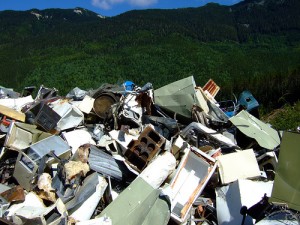Kermit the Frog was right when he said it’s not easy being green. But he didn’t warn us how freakin’ expensive it can be, too. I learned for myself recently, when I got a personal lesson in environmental math and the correlation between corporate brands and environmental responsibility. It all came courtesy of an electric range.
 My 30-year-old Hotpoint stove has been decaying steadily since I bought my house 10 years ago, and when one of the burners fell apart it was time to start socking away money for a new one. I had resisted replacing the stove for years, even though the burners were too small, the oven looked like the gateway to the third ring of hell, and it was the color of an under ripe avocado. Why? Because it worked. And, God help me there must be a penurious Yankee hidden on my family tree someplace, I couldn’t bear to get rid of something that worked. Not just for the money, though that had something to do with it, but because of the environmental impact of throwing out a major appliance. There is close to 200 pounds of steel, copper, plastic and assorted insulating materials in an electric stove. There was no way I could re-use the stove by selling it on Craig’s List or donating it to a charity – it was too old and decrepit. The Hotpoint was landfill fodder, and though my town has an excellent recycling program, the energy and new raw materials consumed by disposing of my old stove and replacing it with a new one weren’t worth it to me.
My 30-year-old Hotpoint stove has been decaying steadily since I bought my house 10 years ago, and when one of the burners fell apart it was time to start socking away money for a new one. I had resisted replacing the stove for years, even though the burners were too small, the oven looked like the gateway to the third ring of hell, and it was the color of an under ripe avocado. Why? Because it worked. And, God help me there must be a penurious Yankee hidden on my family tree someplace, I couldn’t bear to get rid of something that worked. Not just for the money, though that had something to do with it, but because of the environmental impact of throwing out a major appliance. There is close to 200 pounds of steel, copper, plastic and assorted insulating materials in an electric stove. There was no way I could re-use the stove by selling it on Craig’s List or donating it to a charity – it was too old and decrepit. The Hotpoint was landfill fodder, and though my town has an excellent recycling program, the energy and new raw materials consumed by disposing of my old stove and replacing it with a new one weren’t worth it to me.
Then the front left burner crumbled like a Bermie Madoff hedge fund, and it was off to Consumer Reports to find a good quality replacement. I trust Consumer Reports the way I used to trust Larry Bird to hit the game-winning three-pointer with no time left on the clock. I don’t buy a roll of Life Savers unless CR says it’s okay. I’ll pay extra to buy something that CR recommends as a quality product with a long life span and low maintenance costs. So when all signs pointed to yet another Hotpoint in my price range, all that remained was to accumulate the last few bucks of the purchase price and head off to the appliance store.
Then my church had a “sustainable gift fair” for the holiday season, I bought a little book called “The Better World Shopping Guide,” and green reality clubbed me behind the ear.
The Guide rates companies according to a social responsibility formula that includes social justice, animal protection, human rights, community involvement, environmental record. I looked up appliances, found Hotpoint, and almost choked. It wasn’t just rated low, it was rated the lowest – a big fat “F,” alongside General Electric. The Guide counsels against doing business with any company graded “F.” And it doesn’t mince any words. “This category is reserved for companies that are actively participating in the rapid destruction of the planet and the exploitation of human beings. Avoid these products at all costs.” The companies that rated high on the list were the BMWs and Acuras of the world. They were expensive but, according to Consumer Reports, often weren’t a good value and didn’t last as long as the less expensive Hotpoints and GEs.
So there was the choice: a high-quality product with a long life from a company with a crummy environmental rating or a mediocre product from a company with a high environmental rating. A high-quality product from a highly rated company wasn’t an option because by the time I saved enough to buy one the old Hotpoint would have either crumbled or burst into flames.
Ellis Jones, author of “The Better World Shopping Guide” and a professor at Holy Cross College in Worcester, Mass., said my dilemma is pretty common among socially conscious consumers, and that there are no fix-all answers.
“Unfortunately, in a market economy it’s often more expensive to be a responsible corporation, and that cost is passed on to consumers in the form of higher prices,” Jones said. “What I tell consumers is that it’s important to understand the limits of choice and still stick by one’s guns as much as they can in any given situation. Everyone comes to the table with different resources, or they live in an area where they have limited choices of products and companies to buy them from. You can only do the best you can with what you have.”
If we want to make a difference socially and environmentally, Jones said, we have to increase the quality of our purchases, buy from higher rated companies, and decrease the quantity of our purchases. He predicts that it will get easier to buy conscientiously over the coming years because companies realize how social responsibility resonates with their consumers, and they want their brands to represent progressive ideals. In the meantime, he says, we will have to compromise on one front or another when voting with our disposable incomes.
So I compromised. Sort of. I didn’t buy a new stove. Actually, I couldn’t. I had to use the money I saved for a stove to replace the front left fender on my Honda Accord after a hit-and-run driver punched a hole in it. The Honda, with 165,264 miles on it, is a much bigger environmental issue than the stove. And what the hell, I still have three burners left on the stove. Maybe in 2011 …
 educe, Reuse, Recycle. This is the message Jack Johnson is sending to children (and anyone else listening) in his song “The 3 R’s” found on the Curious George Soundtrack “Sing-A-Longs and Lullabies.” It’s one of my son’s favorite songs to sing along to – well for an 18 month old, it’s more like a hum. Today while singing, I turned to him and said, “This is a great song for Earth Day.” He nodded!
educe, Reuse, Recycle. This is the message Jack Johnson is sending to children (and anyone else listening) in his song “The 3 R’s” found on the Curious George Soundtrack “Sing-A-Longs and Lullabies.” It’s one of my son’s favorite songs to sing along to – well for an 18 month old, it’s more like a hum. Today while singing, I turned to him and said, “This is a great song for Earth Day.” He nodded!

